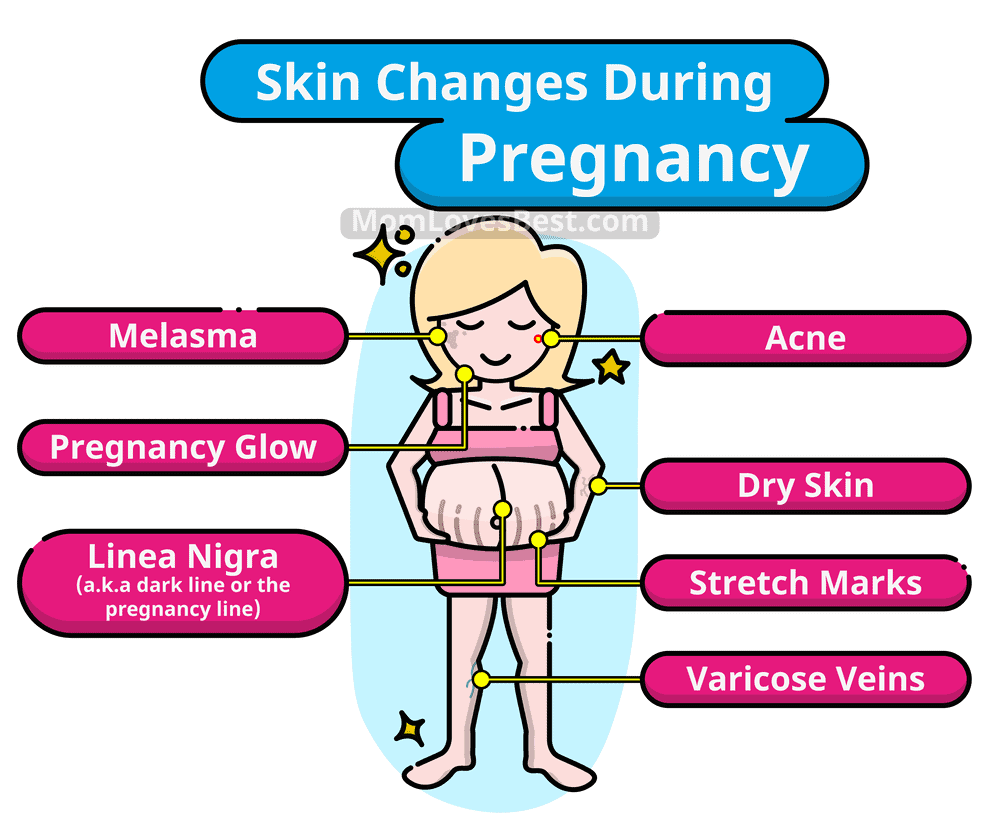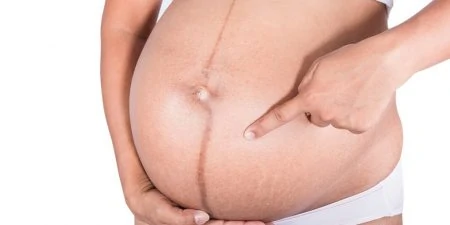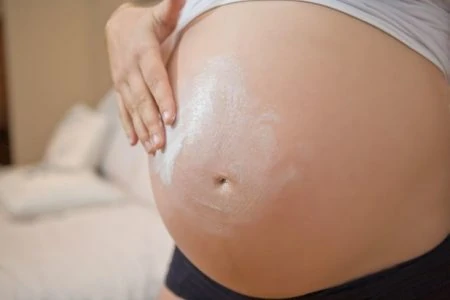Have you noticed any skin changes during your pregnancy? You may be wondering if those changes are normal. Or maybe you are a newly minted mama-to-be and are curious to know what common skin changes may be awaiting you.
Most pregnant women experience some sort of changes to their skin. Some of these changes are totally harmless, while others may cause discomfort and frustration. We know what this is like, so we’ve studied these skin changes and consulted our medical team to find solutions.
We will take a closer look at the seven most common skin changes you may experience during pregnancy to find out how to keep your skin healthy and happy as your baby grows.
We hope this article will give you a better idea of what to expect and what you can do to minimize discomfort and fear during this special time in your life.
Key Takeaways
- Stretch marks are common during pregnancy due to rapid stretching of the skin, and while they can’t be completely prevented, keeping your skin hydrated and maintaining a healthy weight may minimize their occurrence.
- Linea nigra is a dark line that appears on the belly during pregnancy and usually fades within three months after giving birth; it is not harmful and not an accurate predictor of baby’s gender.
- Melasma, or darkened patches of skin on the face, affects 50-70% of pregnant women and is caused by increased hormone production; it typically resolves itself after giving birth and can be managed by avoiding sun exposure and using gentle skincare products.
- Pregnancy acne affects one in two women and is caused by an overproduction of oil; maintaining good hygiene can help manage it, but most acne treatments are not recommended for pregnant women.
Stretch Marks
You have probably heard of stretch marks already. They are one of the most common skin changes women experience during pregnancy.
During my first pregnancy, I made it to my 40-week due date without a single stretch mark. I thought I was getting away scot-free! Flash forward 11 painfully overdue days later. My belly stretched well beyond its capacity, resulting in many painful-looking red stretch marks across my rounded abdomen.
Stretch marks can happen to anyone!
The science behind stretch marks is simple. Think of a rubber band — it stretches and shrinks as you tug and pull on it. Your skin experiences something similar during pregnancy, with rapid stretching and pulling as your belly grows.
According to the American Academy of Dermatology, the collagen and elastin that support your skin rupture during the stretching process (1). A scar then forms as the skin heals. This scar is what we call a stretch mark.
What They Look Like
Can I Prevent Stretch Marks?
The best way to minimize your chance of getting stretch marks is to support your skin’s elasticity.
You can do this by keeping your skin hydrated and moisturized. Shea body butter creams enriched with vitamins, such as Burt’s Bees Belly Butter, are the most popular and are often specifically formulated with your growing belly in mind.
It is also essential to maintain a healthy weight during pregnancy. Rapid weight gain and weight loss will stretch and shrink your skin.
Talk to your doctor about what is an ideal and healthy weight for you during your pregnancy.
Of course, while all of the above may help, the number one determining factor for getting stretch marks is genetics (2). Unfortunately, if your mother or grandmother got them, you may be predisposed to get them!
Unpreventable
How Do I Treat Stretch Marks?
Many women not only dislike the appearance of stretch marks but experience itchiness as well.
Here are two main treatments for stretch marks during pregnancy:
- Use a stretch mark cream with hyaluronic acid or tretinoin. Studies show both effectively reduce the appearance of stretch marks (4).
- If your stretch marks become raised, red, and itchy, you may have pruritic urticarial papules and plaques of pregnancy, also known as PUPPPS (5). They most often appear during your third trimester. Take cool baths and wear loose clothing for at-home relief. If this doesn’t help, try bathing with Epsom Salts or oatmeal. If the rash persists, your doctor may prescribe a steroid cream.
After pregnancy, you can pay a visit to your dermatologist. Laser treatments and chemical peels are sometimes used to reduce the visibility of stretch marks. However, despite what many products and services claim, stretch marks are permanent.
Linea Nigra
Linea nigra refers to the dark line that appears vertically across your belly during pregnancy and is also known as “the pregnancy line.” In general, it stretches from your pelvic area to your belly button. For some women, the linea nigra may extend up to the rib cage.
While no clear cause for linea nigra exists, it is likely connected to the extra estrogen in your body during pregnancy, which can stimulate skin-darkening hormones.
In fact, the linea nigra often exists before pregnancy as the linea alba, a nearly imperceptible white line that darkens as you produce more melatonin during pregnancy.
Does Linea Nigra Go Away?
For most women, linea nigra goes away within three months of giving birth. If you find yourself bothered by the sight of it, avoid getting sun on your belly. Any sort of tan can darken the linea nigra.
Does Linea Nigra Predict Baby’s Gender?
An old wives’ tale claims the linea nigra can predict your baby’s gender.
According to this old tale, if you have a linea nigra that extends from your belly button to your pubic bone, you’re having a girl. If the line goes above your belly button toward your rib cage, you’re having a boy.
There is no scientific evidence to support this claim, but it is fun to think about nonetheless!
Melasma
Is your skin becoming noticeably darker during pregnancy, especially on your face? You may be experiencing melasma, or “the mask of pregnancy.” It is also known as chloasma.
Between 50% to 70% of women experience melasma during pregnancy. It most often manifests itself as darkened patches of skin around your lips and on your cheeks and forehead (6).
Melasma should not hurt and is only another side effect of increased hormone production in your body. If a darkened bit of skin starts to burn, itch, or peel, it may not be melasma, and you should talk with your doctor.
Can I Get Rid of Melasma?
The best way to get rid of and prevent melasma is to limit your exposure to the sun and apply pregnancy sunscreen daily. You will also want to use gentle skin care products and makeup.
Melasma generally resolves itself within the first few months after giving birth. However, a topical bleaching cream called hydroquinone is commonly used to aid the process.
Dry Skin
During your first trimester, you may experience dry skin. I was constantly slathering my skin with lotion to combat the dryness and itchiness my stretching skin was experiencing during pregnancy.
There are two leading causes of dry skin during pregnancy:
- Your body is adjusting to all the new hormones being produced at a high rate. For some women, the skin produces less oil, leading to dry, itchy skin.
- Your body is sending lots of nutrients to your growing baby. The water that benefited you and kept your skin soft will also now be directed away from you and toward your little one.
If your dry skin seems extreme or causes you pain, visit your doctor for guidance and professional treatment.
Treating Dry Skin During Pregnancy
Outside of topical moisturizers and lotions, the best way to treat dry skin during pregnancy is by drinking lots of water. Water will ensure your skin stays hydrated and help you with several other pregnancy woes.
Drinking eight to 12 glasses of water a day can help prevent and alleviate many symptoms, including the following:
- Morning sickness.
- Constipation.
- Heartburn.
- Urinary tract infections.
- Swollen hands and feet.
We suggest getting a fun water bottle like this one. It not only helps you keep track of your water intake, but it also helps you track your pregnancy right on the bottle.
Pro Tip
Acne
One in two women will experience acne during their pregnancy (7). As with most skin changes on this list, hormones are once again the culprit. Whereas dry skin appears due to decreased skin oil production, pregnancy acne is caused by an overproduction of oil.
Are Acne Treatments Safe During Pregnancy?
Unfortunately, many common treatments for acne are not recommended for pregnant women.
You should avoid any acne medications, washes, or creams that contain prescription-strength medicine.
Some experts also suggest avoiding over-the-counter products with salicylic acid, but don’t panic if you have used it during pregnancy. Studies show that the absorption is limited, and it is unlikely to cause your baby harm (8). However, it’s best to avoid it, unless you are using it under the recommendations of a health care provider who knows that you are pregnant.
Editor's Note:
Caitlin Goodwin, MSN, RN, CNMHow to Treat Pregnancy Acne Safely
Hygiene is one of the best ways to treat pregnancy acne. Here are a couple of basic tips:
- Wash your skin twice a day with a gentle cleanser.
- Dry your face by patting the skin, not rubbing.
- Avoid overwashing your face — it may increase oil production.
- Launder your pillowcases frequently.
- Try not to touch your face.
- Do not pop your pimples.
You should see your pregnancy acne clear up in the months after you’ve given birth. If the acne persists, visit your local dermatologist.
Varicose Veins
Your veins pump nutrient-rich blood to your heart. Sometimes, veins become weak or damaged, and blood begins to pool inside, causing them to swell. These engorged veins are known as varicose veins.
Varicose veins can be seen beneath the skin and often look dark blue or purple. They most often appear in the legs.
Varicose veins can occur during pregnancy when the increased pressure from the uterus restricts blood flow to the legs. The blood pools, and the veins swell, often causing pain, itching, and cramping.
How Do I Treat Varicose Veins?
Compression stockings are a common treatment for varicose veins. They are a special type of stocking or sock that improves your blood circulation.
There are many different styles of compression stockings. Some cover the feet, some only go up to the knee, and others are simply tubes that wrap around the calves. Your OB provider can provide insights on what type of compression stocking will work best for you.
Make sure to stay off your feet and elevate your legs regularly if you are experiencing varicose veins. Blood pools more easily in your limbs when you are on your feet. As your belly grows larger, it becomes harder for the blood to circulate to your heart.
Pregnancy Glow
At first, it may seem like all of the skin changes to your body are uncomfortable or unsightly. Take heart! Many women experience “pregnancy glow,” which is just as good as it sounds.
Pregnancy glow causes your face to become plump, firm, and bright. According to the American Pregnancy Association, this appreciated phenomenon occurs due to increased blood flow. As the blood circulates, your skin takes on a more radiant appearance.
Generally, pregnancy glow arrives during your second trimester.
A Note About Pregnancy Skin Regimens
Most women are well-informed about skin care and know a lot about how to wash their skin, which products to use, and at-home remedies for skin problems.
However, when you become pregnant, many factors need to be considered. Check with your health care provider before introducing any new products or making changes to your skin care regimen. They can give you insights into managing all your skin changes during pregnancy.
This fun video goes over some basics of choosing safe skin care products:
Makeup Tips for Pregnant Ladies
You are doing something extraordinary by carrying your baby. As your body changes and skin problems occur during pregnancy, it can be easy to become discouraged. This is especially true when many of these skin changes are out of your control and simply need to be waited out.
No woman should feel pressured to doll herself up during pregnancy, but if you’ve got the energy and want to use makeup to boost your confidence, here are a few tips from a mom who knows:
FAQs
Skin Changes & Pregnancy
As a Certified Nurse-Midwife, I see pregnant women all the time who find it difficult to feel beautiful when pregnant. The skin changes, feeling constipated, and having a bowling ball pressing on their bladder cast doubt on how they think about themselves. It is critical to work to embrace the new you! You are a strong, beautiful woman who is growing your sweet baby, and these changes are normal. Hold space for your emotions during this tumultuous time, but understand that you and your body are amazing.
Editor's Note:
Caitlin Goodwin, MSN, RN, CNMWe understand how frustrating it can be to see your skin change so much during pregnancy. We hope this article provides you with some answers and ideas on how to get through it. If you found this article helpful, we hope you will share it with other moms who could use the information.












